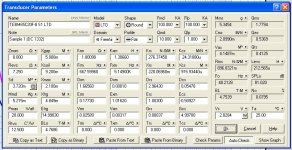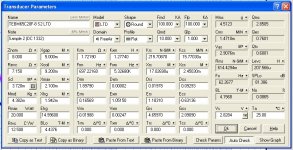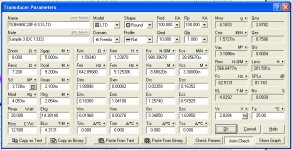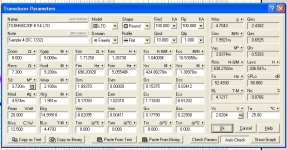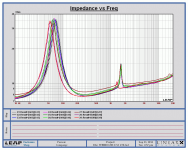I got four TEBM65C20F-8 drivers. This driver has good review at PE forum. I want to try it for a compact bookshelf design.
I started from impedance measurement for extracting parameters. Instead of solely using line-level for small-signal parameter extraction, I used multi-level 0.1 to 5.0 V driving signal to get a set of VI curves. These curves were imported to LEAP to generate LTP models.
One analog output my AP S1 was connected to an amplifier. Output of the amplifier was connected to the driver under test via an 1 R, 1% current sense resistor. Voltage across the driver terminals and current shunt were connected to the two balanced inputs of AP S1, respectively.
Driving levels were 0.1V, 0.2V, 0.5V, 1.0V, 2.0V, 2.83V and 5.0V. Sine sweep with 513 steps was used. Added mass (2g) was used for Mms estimation.
LTD table of the four drivers are shown below. Their resonant frequency are "much" lower than that in the spec. The lowest one is 48.2 Hz. Qts is also much lower than that in the spec. Is it due to different tools for parameter extraction/model fitting or production variation?
Impedance curves of a sample are shown in the figure.
I started from impedance measurement for extracting parameters. Instead of solely using line-level for small-signal parameter extraction, I used multi-level 0.1 to 5.0 V driving signal to get a set of VI curves. These curves were imported to LEAP to generate LTP models.
One analog output my AP S1 was connected to an amplifier. Output of the amplifier was connected to the driver under test via an 1 R, 1% current sense resistor. Voltage across the driver terminals and current shunt were connected to the two balanced inputs of AP S1, respectively.
Driving levels were 0.1V, 0.2V, 0.5V, 1.0V, 2.0V, 2.83V and 5.0V. Sine sweep with 513 steps was used. Added mass (2g) was used for Mms estimation.
LTD table of the four drivers are shown below. Their resonant frequency are "much" lower than that in the spec. The lowest one is 48.2 Hz. Qts is also much lower than that in the spec. Is it due to different tools for parameter extraction/model fitting or production variation?
Impedance curves of a sample are shown in the figure.
Attachments
Yes, it is low. This seems to be the case for all BMR's. Hope that the driver provides other benefits (e.g. wide dispersion) by compromising its sensitivity.
Very interesting results, I too have 4 of these 65C20F-8 BRM's. I plan to experiment with a number of different enclosures to see what works best with these drivers.
-Jim
-Jim
Is this the same driver as the HiWave BMS65? Very ugly response above 10kHz.
From Visaton Diskussionsforum - Einzelnen Beitrag anzeigen - Projekt "Schwachmatt"
An externally hosted image should be here but it was not working when we last tested it.
From Visaton Diskussionsforum - Einzelnen Beitrag anzeigen - Projekt "Schwachmatt"
Yes, this is HiWave BMR65. HiWave is now Tectonic Elements. I will present my freq. response measurement. It is definitely not smooth.
panson_hk,
Thanks for posting your LTD tables for the four driver you have. I have been experimenting with two of these drives in a sealed test enclosure powered by a modified TPA3116 amp to see what they sound like. The shoe box is lined with foam core board for strength and the cambers are separate spaces (~0.12ft/side) and stuffed with polyfill.
Your resonant frequency result may be accurate as the drivers have very impressive bass (low) for their size in a sealed enclosure. They are fast and dynamic as well. I'm happy with the results and would like to try a TL arrangement - your numbers posted will be helpful.
I can verify that these drivers are wide dispersion, low sensitivity, and fairly smooth sounding despite the ragged response.
Thanks for posting your LTD tables for the four driver you have. I have been experimenting with two of these drives in a sealed test enclosure powered by a modified TPA3116 amp to see what they sound like. The shoe box is lined with foam core board for strength and the cambers are separate spaces (~0.12ft/side) and stuffed with polyfill.
Your resonant frequency result may be accurate as the drivers have very impressive bass (low) for their size in a sealed enclosure. They are fast and dynamic as well. I'm happy with the results and would like to try a TL arrangement - your numbers posted will be helpful.
I can verify that these drivers are wide dispersion, low sensitivity, and fairly smooth sounding despite the ragged response.
Attachments
The shoe box is lined with foam core board for strength and the cambers are separate spaces (~0.12ft/side) and stuffed with polyfill.
Thanks for your sharing. Is ~0.12ft the volume of each side?
Hi Panson,
Interesting measurements indeed. I was once fairly interested in these drivers but the shipping cost from PE to our town kills the project. Looking forward to hear your audition comments for these small fellas. I've noticed that BMR drivers are now used in Cambridge Audio's entire range & Naim's flagship, makes me wonder if Tangband's flatcone driver's worth the premium.
Cheers,
Boris
Interesting measurements indeed. I was once fairly interested in these drivers but the shipping cost from PE to our town kills the project. Looking forward to hear your audition comments for these small fellas. I've noticed that BMR drivers are now used in Cambridge Audio's entire range & Naim's flagship, makes me wonder if Tangband's flatcone driver's worth the premium.
Cheers,
Boris
Hi Panson,
Interesting measurements indeed. I was once fairly interested in these drivers but the shipping cost from PE to our town kills the project. Looking forward to hear your audition comments for these small fellas. I've noticed that BMR drivers are now used in Cambridge Audio's entire range & Naim's flagship, makes me wonder if Tangband's flatcone driver's worth the premium.
Cheers,
Boris
Hi Boris,
Yes, shipping cost is always an issue. I will do on and off-axis measurement to see dispersion performance of this driver.
Do you know where I can get that Tangband full-range driver? PE again? It claims wide dispersion too.
Cheers,
Panson
Unfortunately it is difficult for me to DIY where I live now. Otherwise, with the low price of this driver it would be fun to put 8 of them in an hexagonal box (1 on top, 1 on 5 sides and 2 on the remaining side) for a truly omnidirectional box. With the 4 ohm variant you can end up with 8 ohm in total I would also add a tweeter to the side with 2 BMRs, and the terminal at the bottom of the case, this way it would be fun to experiment with direction and tweeter crossover (first used without the tweeter). This would allow for fun experimenting for around $200 pp.
The claimed sensitivity of the commercial speakers is much higher than these parts. Maybe they are using better(more expensive) magnets?I've noticed that BMR drivers are now used in Cambridge Audio's entire range & Naim's flagship, makes me wonder if Tangband's flatcone driver's worth the premium.
Cheers,
Boris
Hi Boris,
Yes, shipping cost is always an issue. I will do on and off-axis measurement to see dispersion performance of this driver.
Do you know where I can get that Tangband full-range driver? PE again? It claims wide dispersion too.
Cheers,
Panson
Oi, you may want to contact Tangband directly via email. If my memory serves me well, they will quote a very reasonable price. Alternatively, you can order on PE or Europe Audio but then you have to pay very expensive shipping.
The claimed sensitivity of the commercial speakers is much higher than these parts. Maybe they are using better(more expensive) magnets?
Naim and Cambridge Audio use other BMR's, instead of this model.
Naim and Cambridge Audio use other BMR's, instead of this model.
I believe Cambridge Audio uses a variant of this driver...
I believe Cambridge Audio uses a variant of this driver...
I followed the RS link, but couldn't find this TEBM46C driver. On the other hand, I can borrow a few HIBM36S12-8A from a friend for measurement. Will post the data later.
Looks like about 85dB at 1W, though as a 4R driver do they mean 1W or an 8R WattI believe Cambridge Audio uses a variant of this driver...
Yes, 0.12ft per driver. I plan on measuring them as well, but it will be a week or so before I get to it. They are okay without a tweeter but would be better with a small one. Maybe just a high pass on the tweeter only.
Looks like about 85dB at 1W, though as a 4R driver do they mean 1W or an 8R Watt
I believe it's more like 82dB @ 2.83V, which is still reasonably efficient for a full range driver of this size, as long as you don't count Fostex FE series.
Which doesn't fit with the Cambridge Audio 90dB/W claimed efficiency at allI believe it's more like 82dB @ 2.83V, which is still reasonably efficient for a full range driver of this size, as long as you don't count Fostex FE series.
- Home
- Loudspeakers
- Full Range
- TEBM65C20F-8 BMR driver
